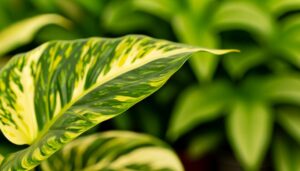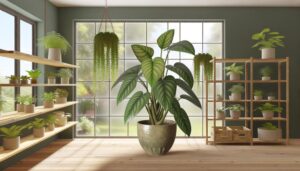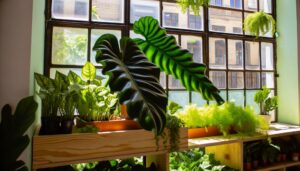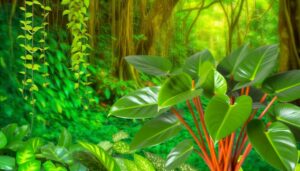What Is the Difference Between Monstera and Philodendron Selloum?
Monstera and Philodendron Selloum are distinct in several aspects. Monstera, native to Central America, exhibits fenestrated leaves up to 90 cm long, thrives in bright, indirect light, and climbs using robust, aerial roots.
In contrast, Philodendron Selloum, originating from South America's tropics, features deeply lobed leaves about 60 cm in length, adopts a spreading growth pattern, and endures moderate, indirect light. Monstera prefers consistent moisture and well-draining soil, while Philodendron tolerates occasional dryness.
These differences dictate specific cultivation practices for prime growth and health, with each offering unique aesthetic and environmental benefits. Explore further for an in-depth understanding.
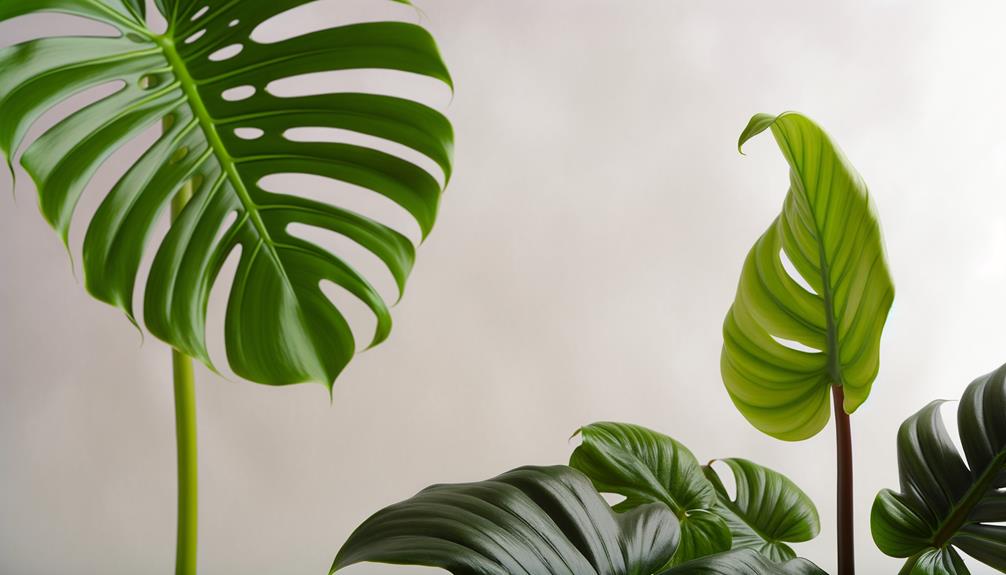
Key Takeaways
- Monstera has fenestrated leaves, while Philodendron Selloum features deeply lobed, feather-like leaves.
- Monstera exhibits a climbing habit with aerial roots; Philodendron Selloum has a spreading growth form.
- Monstera leaves can grow up to 90 cm long, whereas Philodendron Selloum leaves typically reach 60 cm.
- Monstera stems are thick and sturdy; Philodendron Selloum stems are slimmer and elongated.
- Monstera thrives in bright, indirect light, while Philodendron Selloum can tolerate lower light conditions.
Origin and Habitat
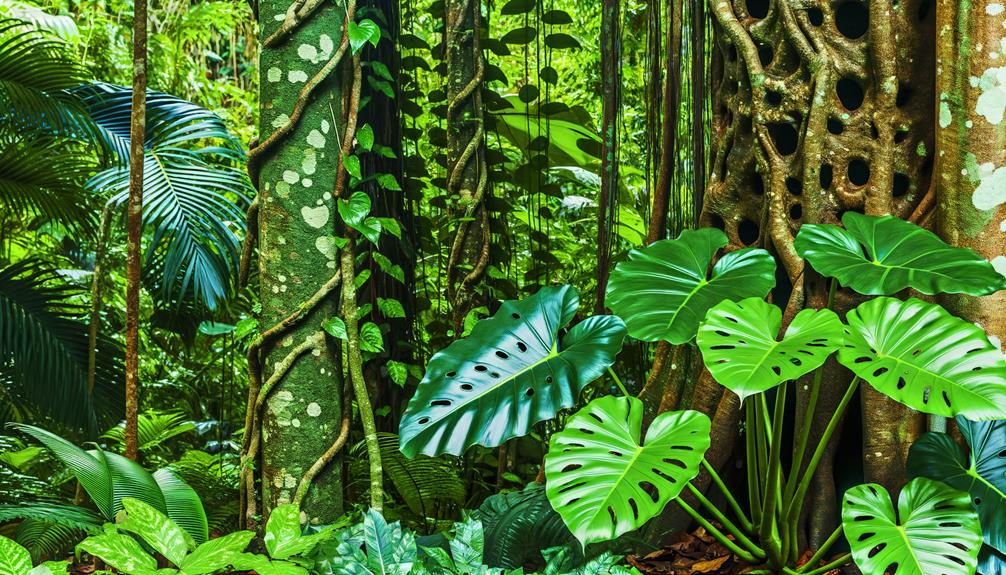
Monstera and Philodendron Selloum have distinct origins and specific habitats where they thrive. Monstera, primarily native to Central America (southern Mexico and Panama), flourishes in tropical rainforests. This genus prefers humid, warm environments with indirect sunlight and often clings to trees via aerial roots.
In contrast, Philodendron Selloum, also known as Philodendron bipinnatifidum, originates from South America's tropical regions, specifically Brazil, Bolivia, and Argentina. It thrives in subtropical forests and swamps, adapting well to both shaded and partly sunny locales. This species shows a preference for well-drained, nutrient-rich soils.
Understanding these plants' distinct geographical and ecological preferences is crucial for successful cultivation, ensuring optimal growth and health in controlled environments.
Leaf Shape
Understanding the distinct leaf morphology of Monstera and Philodendron Selloum is essential for accurate identification and differentiation between these two species. Monstera leaves exhibit profound fenestrations, characterized by deep splits and perforations that evolve as the plant matures. These fenestrations enhance light penetration to lower foliage layers, a notable adaptive trait.
In contrast, Philodendron Selloum, also known as Tree Philodendron, features leaves with deeply lobed margins, resembling a feather-like or pinnatifid structure. The lobes extend symmetrically from a central midrib, creating a more uniform and less perforated appearance compared to Monstera. The intricate lobation in Philodendron Selloum leaves enhances surface area for photosynthesis while maintaining structural integrity.
These morphological distinctions are pivotal for botanists and horticulturists in species identification.
Leaf Size
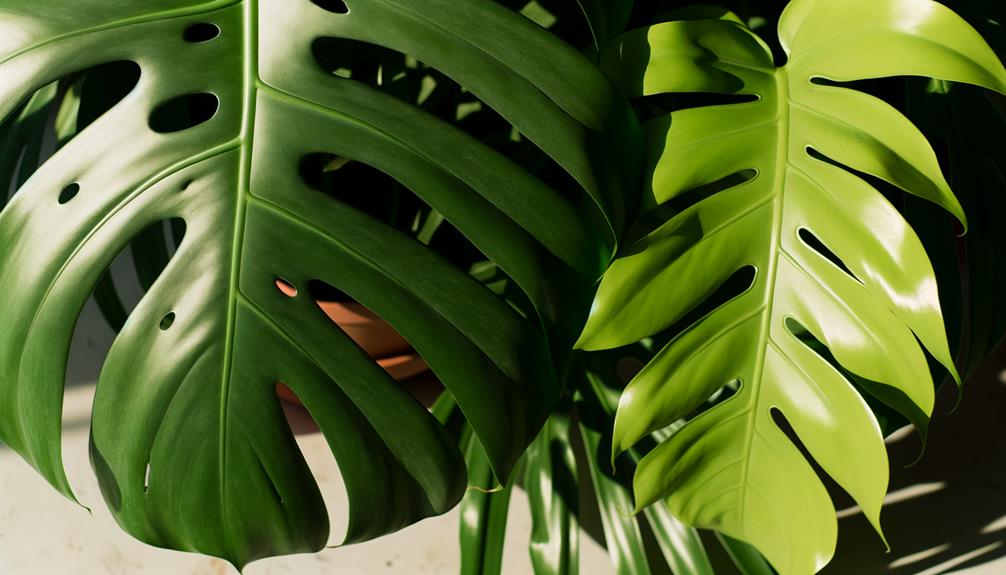
Examining the leaf size reveals that Monstera leaves typically grow larger, often reaching up to 90 cm in length, whereas Philodendron Selloum leaves generally attain a maximum length of approximately 60 cm. This significant difference in leaf size can be attributed to their distinct growth environments and genetic makeup. Monstera leaves, with their expansive surface area, are adapted to capture more sunlight, enhancing photosynthetic efficiency in their native rainforest habitats. In contrast, Philodendron Selloum leaves, while substantial, are relatively smaller, aligning with the plant's growth requirements.
| Plant Species | Maximum Leaf Length | Typical Leaf Width |
|---|---|---|
| Monstera | 90 cm | 60-75 cm |
| Philodendron Selloum | 60 cm | 50-60 cm |
Understanding these differences provides valuable insights into their horticultural care.
Growth Patterns
Monstera and Philodendron Selloum exhibit distinct growth patterns characterized by differences in leaf morphology, climbing versus spreading behavior, and light requirements.
Monstera species typically display fenestrated leaves and a climbing habit facilitated by aerial roots, whereas Philodendron Selloum features deeply lobed leaves and a more shrub-like, spreading growth form.
Additionally, Monstera thrives in bright, indirect light, while Philodendron Selloum can tolerate lower light conditions, influencing their respective growth dynamics.
Leaf Shape Differences
Philodendron Selloum exhibits deeply lobed, pinnate leaves with a more pronounced and consistent division, while Monstera features perforated leaves with fenestrations that vary substantially in size and shape.
The leaf morphology of Philodendron Selloum includes prominent, serrated edges and a symmetrical arrangement, producing a feather-like appearance. In contrast, Monstera leaves demonstrate a unique adaptation through natural perforations, enhancing light penetration and airflow, thereby facilitating growth in dense forest environments.
The fenestrations in Monstera can range from small holes to large splits, often irregularly distributed along the leaf blade. These contrasting leaf structures not only contribute to their aesthetic differences but also reflect their distinct ecological adaptations and evolutionary paths in their native tropical habitats.
Climbing Vs. Spreading
Distinct growth patterns characterize these two species, with Philodendron Selloum displaying a spreading, self-supporting habit, while Monstera exhibits a climbing tendency facilitated by its aerial roots.
Philodendron Selloum, also known as Tree Philodendron, naturally forms a broad, expansive structure supported by thick, self-sustaining stems. Its growth habit involves extensive lateral spread, creating a wide canopy.
In contrast, Monstera deliciosa, known for its iconic fenestrated leaves, employs aerial roots to attach itself to vertical surfaces, enabling it to climb trees and other supports. This climbing mechanism allows Monstera to ascend towards light sources, optimizing photosynthesis.
Understanding these distinct growth behaviors is vital for cultivating these plants in appropriate conditions, whether aiming for vertical or horizontal space utilization in indoor or outdoor settings.
Light Requirements
While both Monstera and Philodendron Selloum thrive under bright, indirect light, their growth patterns and light absorption mechanisms exhibit notable differences due to their distinct structural adaptations.
Monstera, with its fenestrated leaves, maximizes light capture through perforations that reduce shading from overlapping foliage. This adaptation allows it to climb efficiently towards light sources.
Conversely, Philodendron Selloum exhibits a more spreading growth habit, with large, deeply lobed leaves that optimize its ability to capture diffused light across a broader surface area. The Philodendron's horizontal growth pattern enables it to occupy wider spaces, making it adaptable to lower light environments.
Hence, while both species benefit from indirect light, their respective structural features influence their specific light absorption strategies and growth behaviors.
Stem Structure
The stem structure of Monstera and Philodendron Selloum exhibits notable differences regarding thickness, internode length, and the presence of aerial roots.
Monstera stems are generally more essential, with a thicker and sturdier profile, supporting larger leaves. Internodes in Monstera are typically shorter, contributing to a more compact appearance. Aerial roots are prolific, assisting in climbing and nutrient absorption.
In contrast, Philodendron Selloum features slimmer, elongated stems with longer internodes, creating a more open and less dense structure. Aerial roots are present but less abundant compared to Monstera.
These structural variations are important for identifying and understanding the unique growth habits and environmental adaptations of each species.
Root System
Examining the root systems of Monstera and Philodendron Selloum reveals significant differences in their structure and function, closely tied to each species' adaptation to their natural habitats.
Monstera species possess extensive aerial roots, which enable them to anchor onto trees, aiding in vertical growth and nutrient absorption from the surrounding air and debris. These aerial roots are robust and can extend considerable distances.
In contrast, Philodendron Selloum primarily relies on its subterranean root system, which is fibrous and extensive, optimizing nutrient uptake from the soil. This root structure allows Philodendron Selloum to remain firmly grounded and thrive in terrestrial environments.
The distinct root adaptations in both species underscore their evolutionary strategies for survival and resource acquisition in diverse ecological niches.
Light Requirements
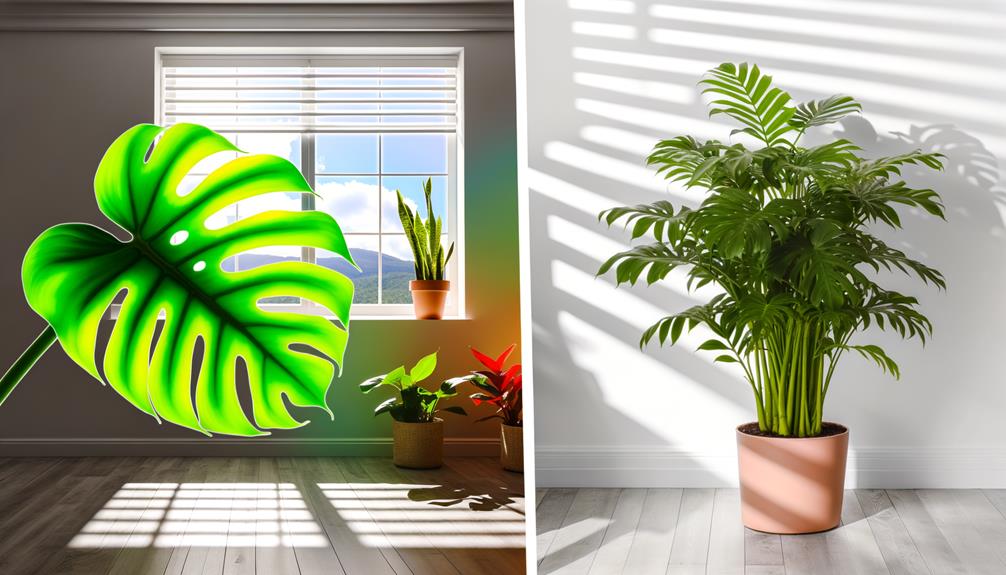
The light requirements for Monstera and Philodendron Selloum exhibit notable distinctions. Monstera thrives in bright, indirect sunlight, whereas Philodendron Selloum can tolerate lower light conditions but benefits from moderate, indirect light.
Both species exhibit some degree of shade tolerance, though inadequate light may affect their growth rates and overall health.
Ideal Sunlight Conditions
Ideal sunlight conditions for Monstera and Philodendron Selloum require a balance of bright, indirect light to thrive without experiencing leaf burn or stunted growth. Both species exhibit prime physiological responses when exposed to light levels that mimic their native tropical habitats.
Specifically, the following conditions should be met:
- Light Intensity: Bright but diffused sunlight (approximately 10,000-20,000 lux) is recommended to prevent photoinhibition.
- Duration: A photoperiod of 12-14 hours daily assures adequate photosynthesis and growth cycles.
- Orientation: Placement near east or west-facing windows provides an ideal equilibrium of light intensity and duration.
- Filtration: Utilization of sheer curtains or blinds can effectively scatter direct sunlight, mitigating risks of foliar damage.
These parameters collectively support healthy development and foliage vibrancy.
Shade Tolerance
While bright, indirect light is ideal, Monstera and Philodendron Selloum also exhibit a remarkable capacity for shade tolerance, adapting efficiently to lower light conditions commonly found in indoor environments.
Monstera, with its fenestrated leaves, continues to maintain robust growth in dimmer settings, though leaf perforation may be less pronounced.
In contrast, Philodendron Selloum, or Thaumatophyllum bipinnatifidum, demonstrates vigorous adaptability, preserving its deeply lobed leaf structure even under suboptimal lighting.
Both species utilize efficient chlorophyll synthesis to maximize photosynthesis in shaded conditions, though prolonged low light may slow growth rates.
Regular rotation of these plants can prevent phototropism, ensuring balanced morphology. Such adaptability makes them exemplary choices for indoor horticulture, where light variability is a common challenge.
Watering Needs
Evaluating the watering requirements of Monstera and Philodendron Selloum reveals distinct differences that are essential for best plant health.
Monstera prefers a more consistent watering regimen, thriving in soil that is kept moderately moist but not waterlogged. Conversely, Philodendron Selloum demonstrates a higher tolerance for occasional dryness, requiring thorough watering when the top inch of soil is dry.
Key observations include:
- Monstera: Requires watering approximately every 1-2 weeks, depending on ambient conditions.
- Philodendron Selloum: Benefits from a deeper watering once the topsoil dries out, generally every 1-2 weeks.
- Humidity Sensitivity: Monstera benefits from higher humidity levels, reducing the frequency of watering.
- Root Rot Susceptibility: Philodendron Selloum is more resistant to root rot, adapting better to irregular watering intervals.
Soil Preferences
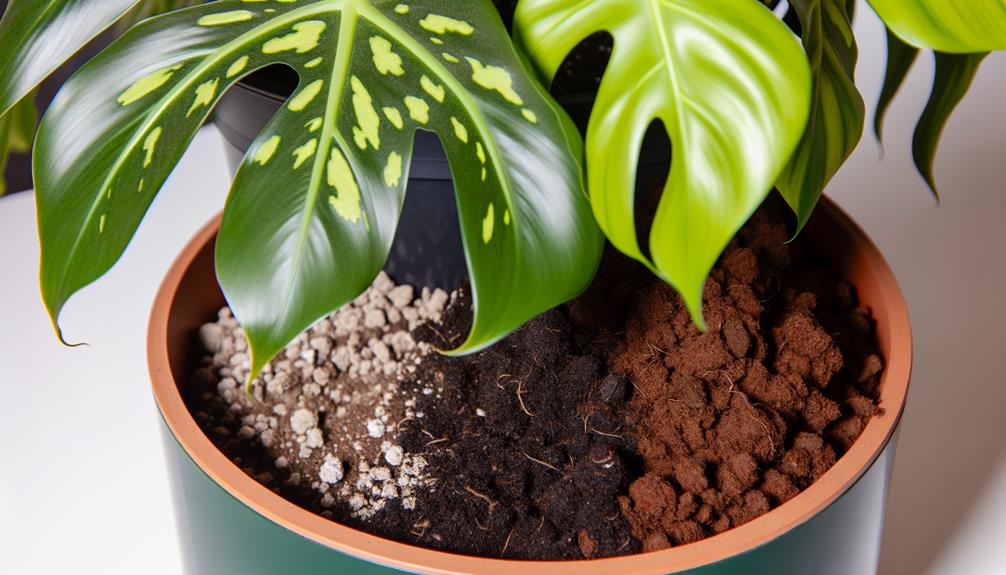
Monstera and Philodendron Selloum exhibit distinct soil preferences, important for best growth. Both species thrive in well-draining soil, yet their moisture retention needs differ, with Monstera favoring slightly more aerated substrates.
Additionally, the ideal pH levels for these plants must be carefully regulated, usually ranging from slightly acidic to neutral.
Well-Draining Soil Requirements
Both Monstera and Philodendron Selloum thrive in well-draining soil that prevents waterlogging and promotes ideal root health. The best soil composition for these plants should include a balance of organic and inorganic materials that ensure efficient drainage while retaining essential nutrients.
To achieve this, consider the following components:
- Peat moss: Enhances moisture retention while providing good aeration.
- Perlite: Improves drainage and prevents soil compaction.
- Bark chips: Facilitate air circulation and further enhance drainage.
- Compost: Supplies essential nutrients and supports microbial activity.
These elements create a substrate that mimics the natural habitat of Monstera and Philodendron Selloum, promoting strong growth and reducing the risk of root rot.
Regular monitoring and adjustments are essential to maintaining the best soil conditions for these tropical plants.
Moisture Retention Needs
Understanding the moisture retention needs of Monstera and Philodendron Selloum is crucial for ensuring the finest growth and preventing common issues such as root rot.
Monstera prefers soil that retains moderate moisture without becoming waterlogged. It thrives in substrates that balance moisture retention and aeration, such as a blend of peat, perlite, and orchid bark.
Conversely, Philodendron Selloum demands a slightly higher moisture retention. Its ideal substrate leans towards a loamy, organic-rich mix with components like peat moss and compost, which hold moisture yet provide adequate drainage.
Both plants benefit from allowing the topsoil to dry out between waterings, but precise moisture management tailored to their specific needs is crucial for excellent health and growth.
Ideal Ph Levels
In addition to their distinct moisture retention needs, the best pH levels for Monstera and Philodendron Selloum are crucial for nutrient availability and overall plant health. Both species thrive in slightly acidic to neutral soil, but ideal pH ranges can differ slightly:
- Monstera: Prefers a pH range of 5.5 to 7.0, allowing for efficient nutrient uptake and root development.
- Philodendron Selloum: Favors a pH range between 5.0 and 6.0, which supports its metabolic processes and growth.
- Soil Testing: Regular pH testing is recommended to guarantee the soil remains within the ideal range.
- Amendments: Adjusting soil pH with lime to raise it or sulfur to lower it can help maintain the appropriate conditions.
Proper pH management is crucial for sustaining healthy, vigorous growth in these plants.
Common Pests
Monstera and Philodendron Selloum are often prone to common pests such as spider mites, aphids, and scale insects.
Spider mites (Tetranychidae) are tiny arachnids that thrive in dry conditions, leading to stippling and bronzing of leaves.
Aphids (Aphidoidea) excrete a sticky substance known as honeydew, promoting sooty mold growth and potentially spreading viral diseases.
Scale insects (Coccoidea) attach themselves to stems and leaves, extracting sap which weakens the plant, causing yellowing and premature leaf drop.
Regular inspection and early intervention are essential for managing infestations. Effective control strategies include isolating affected plants, applying insecticidal soap, and maintaining ideal humidity levels to deter spider mites.
Consistent monitoring ensures plant health and reduces pest proliferation.
Propagation Methods
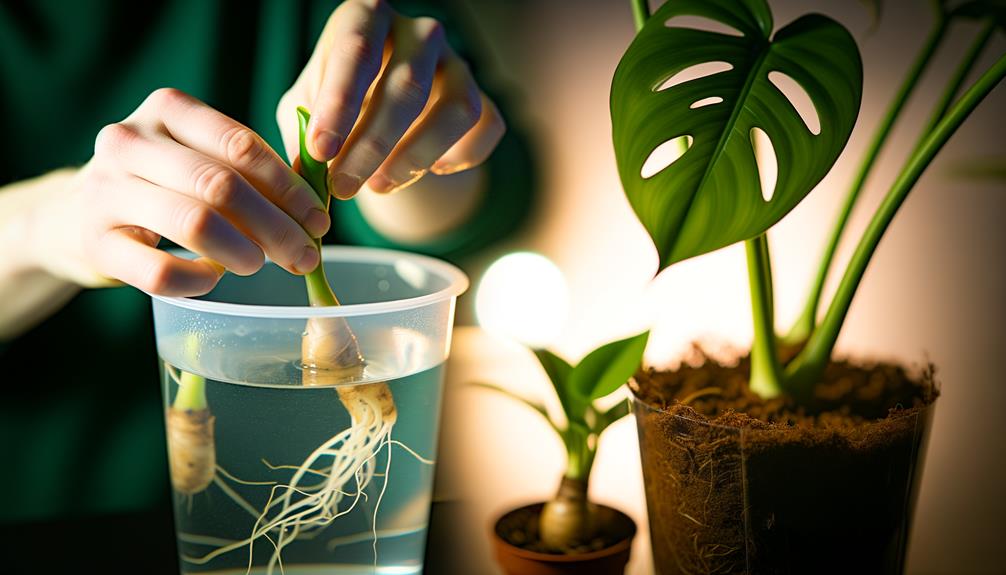
After ensuring the health and pest-free status of your plants, exploring the propagation methods for Monstera and Philodendron Selloum can enhance your collection and knowledge of these species.
Both plants propagate efficiently via vegetative methods, though their techniques differ slightly.
- Stem Cuttings: For Monstera, select a healthy stem with aerial roots and nodes. Place it in water or a well-draining soil mix.
- Air Layering: This method is particularly effective for Monstera. Encase a section of stem with damp sphagnum moss and wrap in plastic until roots develop.
- Division: Philodendron Selloum propagates well through root division. Gently separate the root clumps and replant individually.
- Leaf-Bud Cuttings: Less common but viable, this involves cutting a leaf with its bud and planting it in a suitable medium.
Conclusion
To sum up, Monstera and Philodendron selloum, though often confused, exhibit stark differences in origin, leaf morphology, growth patterns, stem structure, and care requirements.
The Monstera's fenestrated foliage contrasts sharply with the deeply lobed leaves of Philodendron selloum.
Monstera's climbing growth habit diverges from Philodendron's more shrub-like form.
Understanding these distinctions is crucial for best cultivation.
In the grand tapestry of botanical wonders, these plants stand as titanic exemplars of nature's diversity and adaptability.


